National No Smoking month: Cigarette alternatives just as harmful
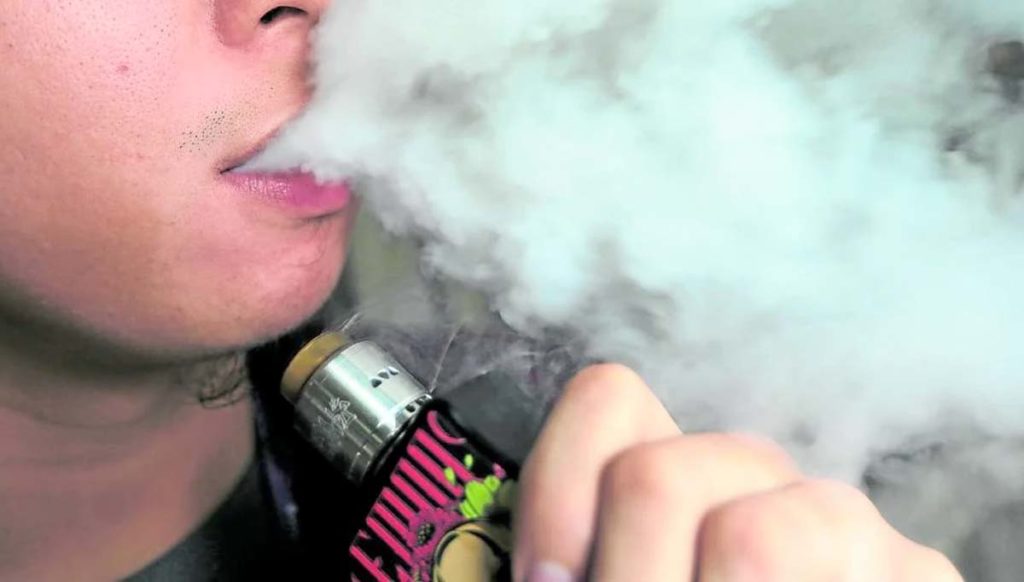
MANILA, Philippines—Every June, Filipinos are being encouraged to stop smoking as the country observes the National No Smoking Month—which highlights the harmful effects of tobacco products.
June was declared National No Smoking Month by Proclamation No. 183 signed in May 1993 under then-President Fidel V. Ramos.
“[A]s part of the awareness campaign on the ill-effects of cigarette smoking, the Department of Health if joining the World Health Organization in the annual celebration of the “World No Tobacco Day,” the proclamation stated.
“[T]here is a need to focus national attention to the dangers of smoking,” it added.
This year, aside from warning and reminding the public of the harmful impacts of smoking on one’s health and the environment, health experts and the government are faced with another challenge—the increasing use of e-cigarettes, heated tobacco products, and vapor products among Filipinos, including the youth.
Heated tobacco products, as defined by Republic Act No. 11467, refer to tobacco products that are consumed through heating tobacco, either electrically or through other means “sufficiently to release an aerosol that can be inhaled without burning or any combustion of the tobacco.”
These products include liquid solutions and gels that are part of the product and are heated to generate an aerosol.
Vapor products were meanwhile defined as electronic nicotine and non-nicotine delivery systems (ENDS/ENNDS).
These could be a combination of a liquid solution or gel which transforms into an aerosol without combustion through a mechanical or electronic heating element, battery, or circuit that can be used to heat such solution or gel.
Vapor products also include a cartridge, a tank, and the device without the cartridge or tank. It is commonly known as nicotine salt or salt nicotine, and conventional “freebase” or classic nicotine, and other similar products.
E-cigarettes, according to the United States Centers for Disease Control and Prevention (US CDC), come in different shapes and sizes. Nowadays, some e-cigarette products available in the market look like regular cigarettes, cigars, or pipes.
Others look like USB flash drives, pens, and even other everyday items. Some e-cigarettes, such as tank systems or “mods,” are much larger in size and do not resemble other tobacco products.
Alternative to smoking?
As the future of the proposed Vaporized Nicotine Products Regulation Act, or the Vape Bill remains uncertain, proponents of the bill and endorsers of vaping push for its passage amid an outcry from health experts and youth protection advocates.
The pending Vape Bill, which passed the House of Representatives and the Senate—with both versions reconciled by a bicameral conference committee—seeks to regulate vaporized nicotine (vape) and non-nicotine products as well as novel tobacco products.
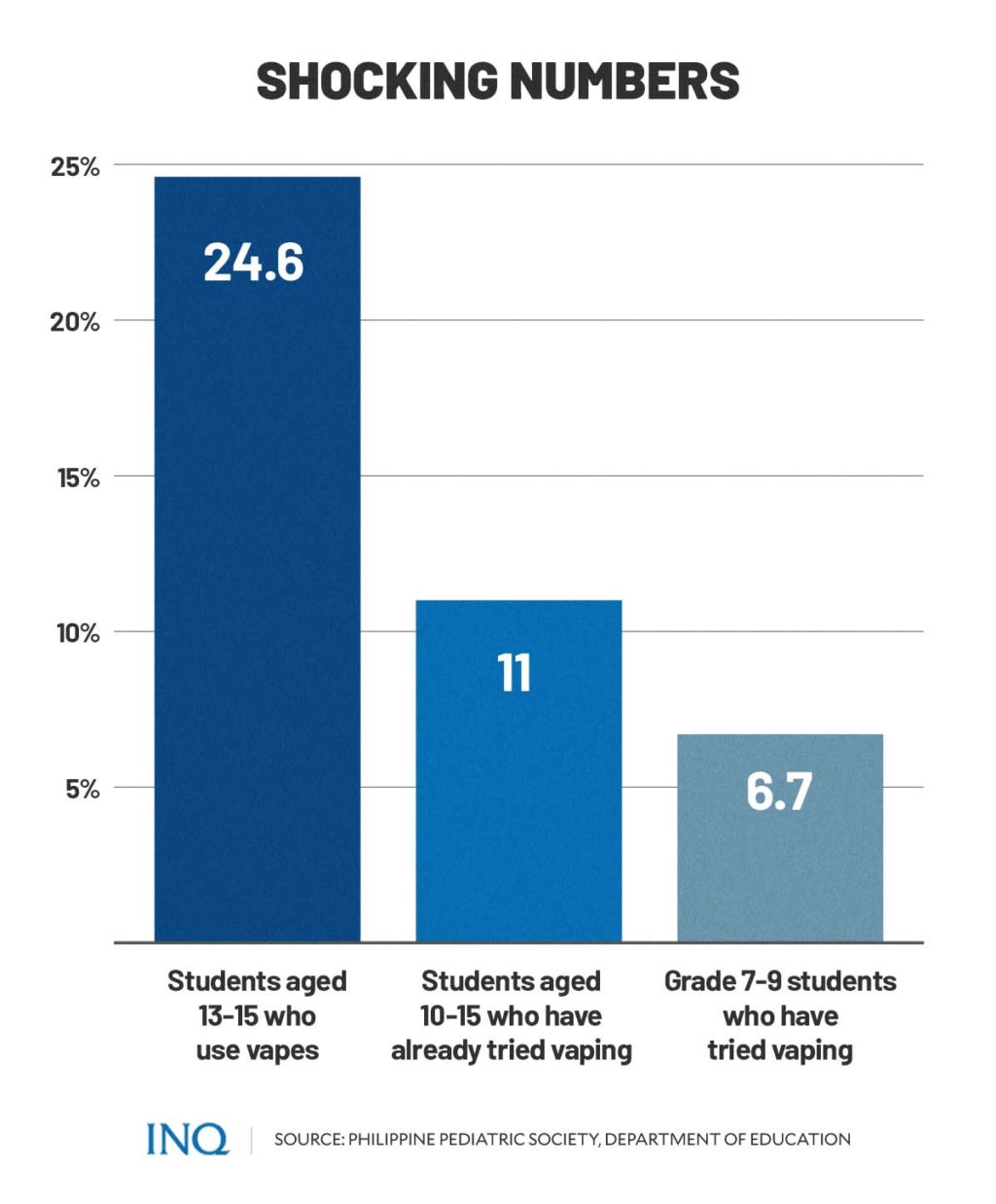
GRAPHIC: Ed Lustan
The bill is currently up for Duterte’s signature after the House of Representatives ratified in January the report of the bicameral conference committee which reconciled the disagreeing provisions of Senate Bill No. 2239 and House Bill No. 9007.
One of the main reasons why supporters of the bill are pushing for its passage was that once approved, it will supposedly give access to around 16 million Filipino smokers to alternatives to smoking—such as vape, e-cigarettes, or heated tobacco products (HTPs)—while providing strict safeguards to ensure that minors and non-smokers do not have access to these products.
“The logical conclusion is that vapor products will save the lives of 16 million Filipino smokers or at the very least reduce their health risks. Therefore, regulation and not prohibition is key. This is what the vape bill seeks to do,” said Fernando Fernandez, secretary general of Asia Pacific Dental Federation and the past president of the Philippine Dental Association.
READ: Opposition to Vape Bill may exacerbate smoking, top Filipino doctors say
Some former smokers also said vapor products have helped them throw away their habit of smoking tobacco products.
“It took me a very long time to stop smoking. Without vapor products, I would not have been able to fully stop. The reality is many smokers will try to stop smoking, but will never be successful. That is what the WHO data says,” said Dr. Telesforo Gana, past president of the Philippine Urological Association and past chair of the Philippine Board of Urology.
“Smoker’s lives matter too. We should not look at them as statistics. We need to have pragmatic solution to end the smoking epidemic. I hope the Vape Bill can be that solution so we can save the lives of 16 million Filipino smokers,” he added.
Some advocates of vapor products meanwhile stressed that vapor products are far less harmful than smoking cigarettes, thus making it a better alternative, especially for those who are trying to quit smoking.
“The science supporting vaping and heated tobacco as less harmful alternatives to cigarettes can’t be denied anymore. Progressive countries including the US, the UK, New Zealand and many more have embraced these non-combustible alternatives, following extensive scrutiny by their respective public health institutions,” said Joaqui Gallardo, spokesman of Vaper AKO.
“More and more adult smokers who had no success in quitting smoking before have finally found what works for them to kick the deadly habit. A UK study concluded that non-combustible alternatives are twice as effective compared to nicotine replacement therapy in helping smokers quit,” said Anton Israel, president of the Nicotine Consumers Union of the Philippines (NCUP).
Israel added that “more than a million papers have already left smoking behind with the help of vapes and heated tobacco products.”
READ: Vape bill gives 16 million Filipinos a chance to evade harm from smoking
Vapes, e-cig still harmful
While supporters and users of e-cigarettes and vaping maintain that such products offer less harmful impact on users than cigarettes, many health experts—including the DOH—emphasized that those products are still harmful to a person’s health.
According to the country’s health department, e-cigarettes or vapor products are “harmful and not risk-free” and “should be regulated as health products due to their toxic substances and effects.”

GRAPHIC: Ed Lustan
“Vape liquids and their emission contain chemicals such as nicotine, propylene glycol, carbonyls, and carbon monoxide that are either addictive, toxic, or can cause cancer,” DOH explained.
“Additionally, studies have shown vape use increases the risk of using other known addictive substances such as cigarette use, alcoholism and even marijuana use. There is also growing evidence of the harmful effects of using vapes both to the user and those exposed to its emissions, including its potential to cause cardiovascular diseases, respiratory problems and explosion injuries,” it added.
The World Health Organization (WHO) also said that ENDS such as e-cigarettes may contain varying amounts of nicotine and harmful emissions.
“E-cigarette emissions typically contain nicotine and other toxic substances that are harmful to both users, and non-users who are exposed to the aerosols secondhand. Some products claiming to be nicotine-free have been found to contain nicotine,” said WHO.
“Evidence reveals that these products are harmful to health and are not safe. However, it is too early to provide a clear answer on the long-term impact of using them or being exposed to them,” it added.
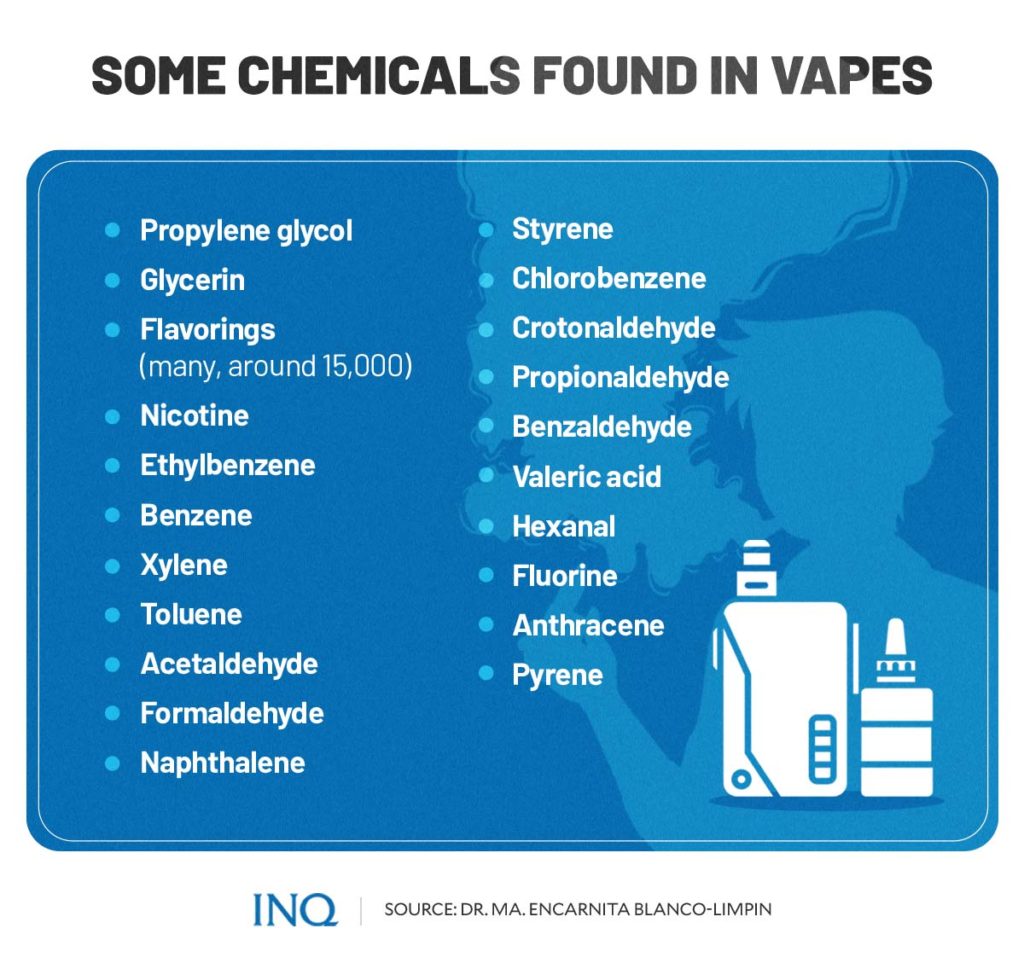
GRAPHIC: Ed Lustan
At an online forum hosted by the Philippine College of Chest Physicians (PCCP) for the World No Tobacco Day, PCCP president Ma. Encarnita Blanco-Limpin presented some of the more than 100 chemicals found in aerosols of e-cigarettes and vapor products.
These chemicals include:
- Propylene glycol
- Glycerin
- Flavorings (many, around 15,000)
- Nicotine
- NNN
- NNK
- NAB
- NAT
- Ethylbenzene
- Benzene
- Xylene
- Toluene
- Acetaldehyde
- Formaldehyde
- Naphthalene
- Styrene
- Benzo(b)fluoranthene
- Chlorobenzene
- Crotonaldehyde
- Propionaldehyde
- Benzaldehyde
- Valeric acid
- Hexanal
- Fluorine
- Anthracene
- Pyrene
- Acenaphthylene
- Acenapthene
- Fluoranthene
- Benza(a)anthracene
- Chrysene
- Retene
- Benzo(a)pyrene
- Indeno(1,2,3-cd)pyrene
- Benzo(gh)perylene
- Acetone
- Acrolein
- Silver
- Nickel
- Tin
- Sodium
- Strontium
- Barium
- Aluminum
- Chromium
- Boron
- Copper
- Selenium
- Arsenic
- Nitrosamines
- Polycyclic aromatic hydrocarbons
- Cadmium
- Silicon
- Lithium
- Lead
- Magnesium
- Manganese
- Potassium
- Titanium
- Zinc
- Zirconium
- Calcium
- Iron
- Sulfur
- Vanadium
- Cobalt
- Rubidium
According to Limpin, more than 20 chemicals on the list are on the Philippine Food and Drug Administration’s (FDA) 2012 list of harmful and potentially harmful substances.
“E-cigarettes produce aerosols that often contain many harmful chemicals and toxins, some known to cause cancer,” she said.
She also noted that most of these chemicals are also present in aerosols generated from cigarettes or traditional tobacco products.
WHO said that it is “still difficult to generalize on the risk to the health of ENDS as compared with cigarettes or other tobacco products, as this is contingent on a range of factors.”
“Both tobacco products and ENDS pose risks to health.,” said WHO.
The safest approach, according to WHO, is to not use either.
Johns Hopkins Medicine said e-cigarettes are not the best smoking cessation tool.
“Although they’ve been promoted as an aid to help you quit smoking, e-cigarettes have not received Food and Drug Administration approval as smoking cessation devices.”
“A recent study found that most people who intended to use e-cigarettes to kick the nicotine habit ended up continuing to use traditional and e-cigarettes.”
E-cig, vape effects on the body
Pulse Asia, in a commissioned survey conducted last year, found that 8 out of 10 Filipinos—77 percent of 1,200 adult respondents—believe that e-cigarettes pose a “serious health hazard” to users.
At least 15 percent said it is a minor health hazard, while two percent said it is not.
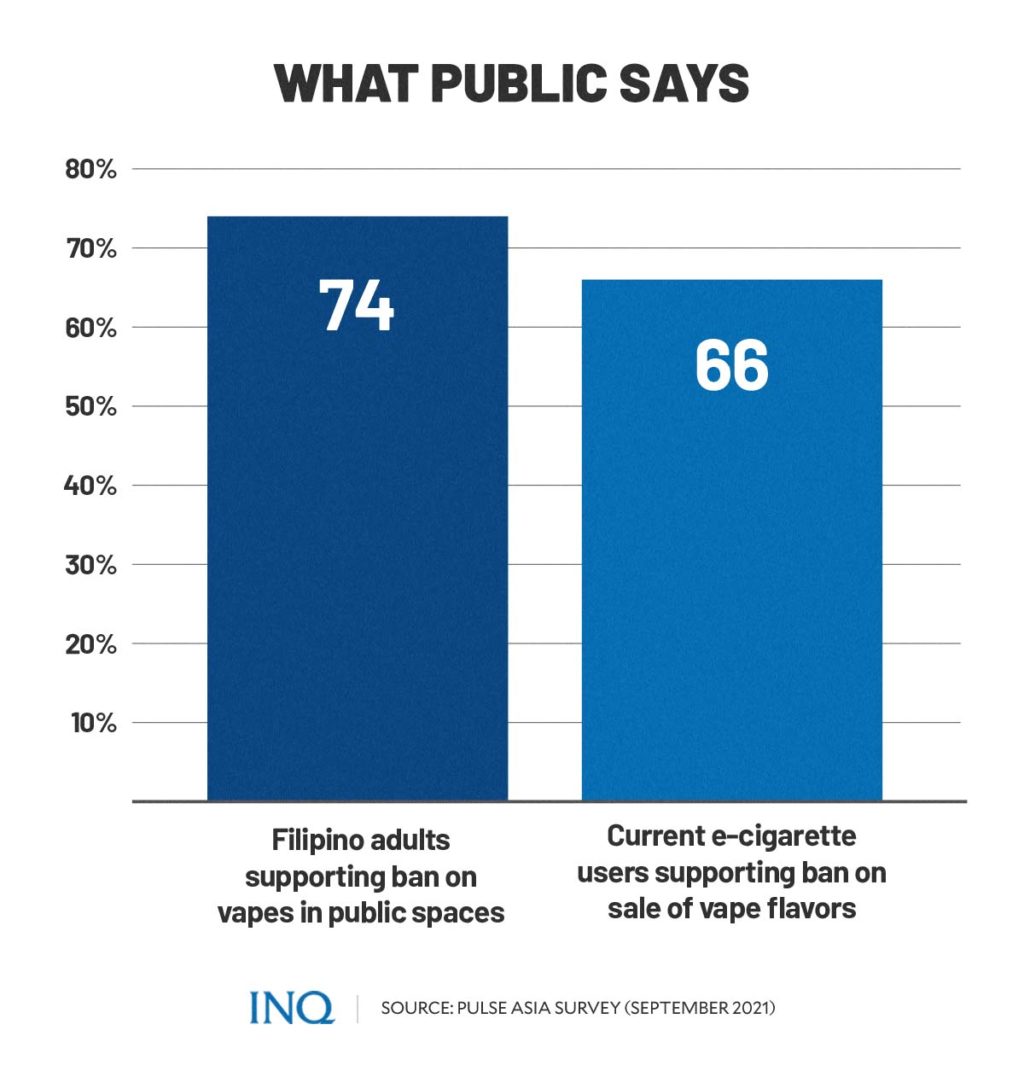
GRAPHIC: Ed Lustan
Health hazards of vaping or consuming e-cigarettes vary, but a 2021 study published in the International Journal of Environmental Research and Public Health showed that at least 40 percent of e-cigarette users reported experiencing vaping side effects on a daily basis.
Some of the common e-cigarette side effects include:
- burning or scratchy feeling in the mouth, lips, and throat
- cough
- dizziness
- dry/sore mouth and throat
- headache
- heart palpitations
- shortness of breath
- sleepiness
- weakened taste
Consumer advocacy organization Drugwatch also listed some of the potentially serious side effects of vaping, albeit rare, which include:
- nicotine addiction
- severe lung injury
- seizures
- cryptogenic organizing pneumonia (COP), formerly known as idiopathic bronchiolitis obliterates with organizing pneumonia (BOOP)
- popcorn lung
- strokes
- heart attacks
In 2020, the US CDC reported an outbreak of lung injuries and deaths associated with vaping. There were around 2,807 confirmed cases of e-cigarette or vaping use-associated lung injury (EVALI) and 68 deaths attributed to that condition in the US as of February that year.
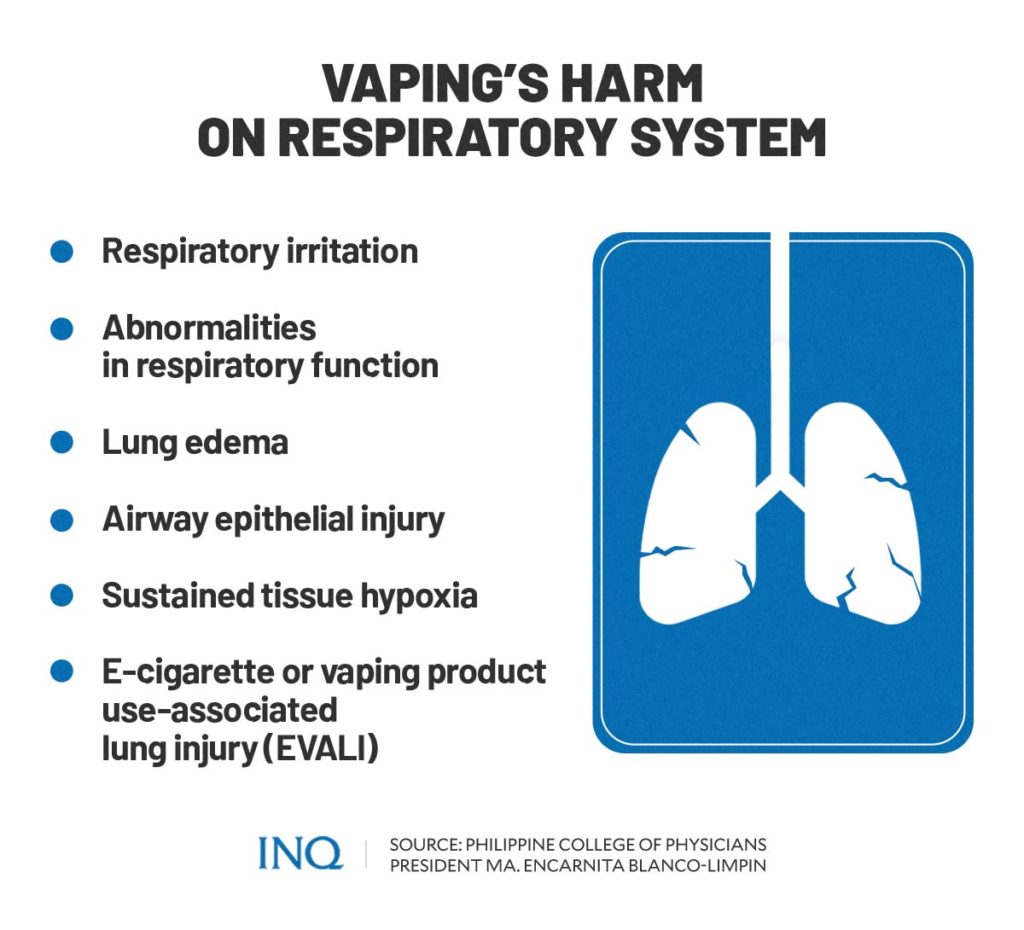
GRAPHIC: Ed Lustan
In the Philippines, the DOH received an official report on the first case of EVALI in November 2019 from a private pediatric pulmonologist based in the Visayas.
According to the case report, the patient was a 16-year-old female adolescent who had been using e-cigarettes for six months “while concurrently consuming combustible cigarettes, referred to as ‘dual use’.”
The patient, who was admitted to the hospital in October that year, “initially presented with sudden-onset severe shortness of breath, required oxygen supplementation and ICU admission. Upon admission, the clinical impression was initially considered to be infectious in nature.”
“All e-cigarette users should seek immediate medical help, and ask their doctors for ways to quit these harmful products. No e-cigarette product should be accessible to young children and adolescents, who are uniquely susceptible to the harms of e-cigarettes and nicotine. I urge non-users not to even try e-cigarettes at all,” then Health Undersecretary Rolando Enrique Domingo stated.
Aerosol generated by e-cigarette use or vaping, according to US CDC, is not just “harmless ‘water vapor’,”
The e-cigarette aerosol that users breathe from the device and exhale can contain harmful and potentially harmful substances, including:
- nicotine
- ultra fine particles that can be inhaled deep into the lungs
- flavorings such as diacetyl, a chemical linked to a serious lung disease
- volatile organic compounds
- cancer-causing chemicals
- heavy metals such as nickel, tin, and lead
“The aerosol that users inhale and exhale from e-cigarettes can expose both themselves and bystanders to harmful substances,” the US CDC said.
“It is difficult for consumers to know what e-cigarette products contain. For example, some e-cigarettes marketed as containing zero percent nicotine have been found to contain nicotine.”
READ: Vape Bill: Unresolved debate on vaping’s risks, benefits now to reach Duterte’s table
Youth at risk
At the same forum recently hosted by PCP, Dr. Boss Sobremesana—medical officer of the DOH Health Promotion Bureau—presented figures which showed the increasing popularity of e-cigarettes and vapor products among adults and the Filipino youths.
Citing data from the 2015 Global Adult Tobacco Survey (GATS) and Pulse Asia survey conducted last year, the percentage of “current use of electronic cigarettes (used e-cigarettes in the past 30 days)” among Filipino adults aged 15 years and above increased by 400 percent—from 0.8 percent in 2015 to 4 percent in 2021.
The “ever use of electronic cigarettes (ever used e-cigarettes in their entire life)” among Filipino youths aged 13 to 15 years old increased by 110 percent—from 22.7 percent in 2015 to 24.6 percent in 2019.
“We can see here that in terms of how attractive these vapor products or heated tobacco products are…it’s meant to attract the youth. That’s not actually contributing to lessen the harm of these products, it actually increases it,” said Sobremesana.
“It exposes more people since it targets the youth,” he added.
As years pass by, more youths continue to use e-cigarettes and vapor products.
A study conducted by the Philippine Pediatric Society showed that 11 percent of students aged 10 to 15 years old have already tried vapes.
Citing the study, the Department of Education (DepEd) reported that 6.7 percent of Grades 7 to 9 students were found to “have tried and are using e-cigarettes.”
Among the top reasons for vape use among students were online accessibility (32 percent), varied flavors (22 percent), and the belief that e-cigarettes are safer than tobacco (17 percent).
Health experts, along with the DepEd and DOH, feared that if the Vape Bill is passed into law, the number of youth using e-cigarettes or vape—whether for the first time or not—will increase further.
“If the Vape Bill is passed, we should expect more young people to be lured into this harmful vice and eventually lead to fatal addiction to cigarettes,” said Toni Flores, Child Rights Network coordinator.
According to DepEd data, at least 870,000 learners in the basic education sector for School Year 2020 to 2021 are 18 years old, while close to 1.1 million learners in senior high school are 18 to 20 years old.
“This is the number of learners who will become legally allowed to be marketed the harmful products once the bill becomes law,” DepEd stressed.
“As we continue to implement a comprehensive tobacco control program in schools to safeguard the health of learners, DepEd is hopeful that our leaders and legislators will constantly champion a healthy lifestyle among our youth,” the department said.
READ MORE:
Smoke, not nicotine, causes deaths – health expert
Disclaimer: The comments uploaded on this site do not necessarily represent or reflect the views of management and owner of Cebudailynews. We reserve the right to exclude comments that we deem to be inconsistent with our editorial standards.
